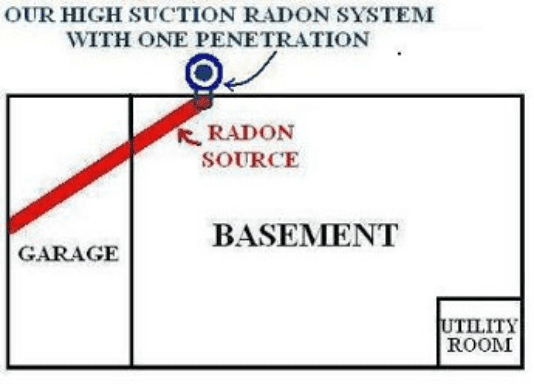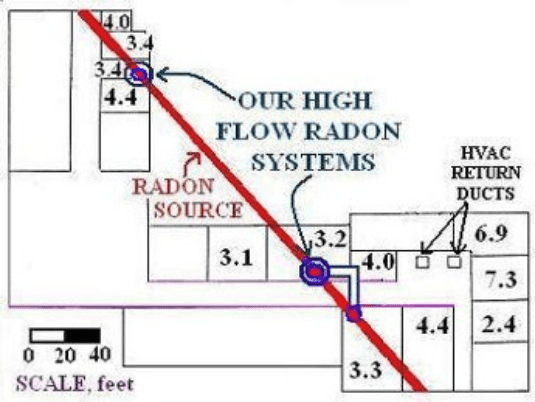Precision Radon Solutions: Science-Driven Remediation
THE CRUX OF RADON REMEDIATION IS TO HAVE THE ABILITY TO CORRECTLY IMPLEMENT AND INTERPRET SCIENTIFIC DIAGNOSTIC ANALYSES RATHER THAN WORKING BY TRIAL AND ERROR
OUR UNIQUE PROPRIETARY METHODS are performed the day of installation to ensure that our remediation systems are effective that day and that radon levels are minimized.
SUB-SLAB AIR-FLOW PERMEABILITY ANALYSES
Two 1/2″ diameter holes are drilled through the slab at appropriate distances apart. By applying a known negative pressure to one hole and measuring the differential pressure drop with time from the other hole using a micromanometer, we calculate the magnitude of sub-slab air flow permeability, based upon both our empirical data and theoretical fluid mechanics. From this analysis we can determine if one basic system can be installed in the aesthetically least obtrusive place or if the second set of analyses (2 and 3) need to be performed. This method also enables us to determine interior footing locations if building plans are not available. Of equal importance, we install the most effective and efficient fan based upon these specific analyses and design calculations.
GEOLOGICAL AND SUB-SLAB RADON ANALYSES
PERFORMED WHEN SUB-SLAB PERMEABILITY IS VERY LOW, ESPECIALLY IN OLDER HOMES SINCE THEY HAVE LIMITED OR NO SUB-SLAB GRAVEL AND THE FOUNDATION SLAB IS POURED DIRECTLY ON SOIL. THE SOIL IS TOO IMPERMEABLE FOR ANY RADON FAN TO PULL FROM MORE THAN A FEW FEET UNDER THE SLAB. THESE ANALYSES ARE ALSO IMPERATIVE IN ALL LARGE BUILDINGS
Our scientists plot each building on a site-specific geologic map to determine the precise orientation of the bedrock layers along which the radon sources are located. Several on-site sub-slab radon analyses with our Pylon alpha scintillometer are then performed on soil gas samples evacuated from very small holes through the slab. These results are coupled with the site-specific geology to contour the soil radon concentration gradients, thereby precisely locating the radon source or sources under the building. The source is then extrapolated to outside walls so that a system penetration can be located directly over the source, eliminating the need for pipes in the middle of rooms. This RCP proprietary methodology thus minimizes the number of pipes and cost of sub-slab depressurization systems required while maximizing radon reduction and ensuring successful follow-up radon test results.
BLOCK WALL RADON MEASUREMENTS
When block walls exist, we usually measure the radon levels in the interior of the walls to determine if they need to be remediated by adding a small PVC “T” from the main system pipe.
OUR SUCCESSFUL REMEDIATION OF AN OLDER HOUSE WITH NO SUB-SLAB GRAVEL

OUR SUCCESSFUL REMEDIATION OF A LARGE BUILDING WITH SUB-SLAB GRAVEL (numbers are original radon levels)

** HOWEVER, IF THE RADON SYSTEM HAD BEEN LOCATED IN THE UTILITY ROOM IN THE HOME (THE MOST UNOBTRUSIVE LOCATION) OR THE ROOMS WITH HIGHEST RADON LEVELS IN THE LARGE BUILDING, EVEN WITH MORE PIPES AND PENETRATIONS INSTALLED IN VARIOUS OTHER PLACES LATER, THE NEGATIVE PRESSURE FIELD WOULD LIKELY NOT EXTEND TO THE SOURCE. THEREFORE, THE RADON WOULD NOT BE AS REDUCED AND THERE WOULD BE EXTRA TRIPS TO INSTALL MORE PIPING AT MORE EXPENSE **
Join Us
Join Radon Control Professionals Inc for a rewarding career journey. Discover an environment of innovation, collaboration, and growth. Your skills matter, and so does your impact. Explore opportunities and start your fulfilling career today.